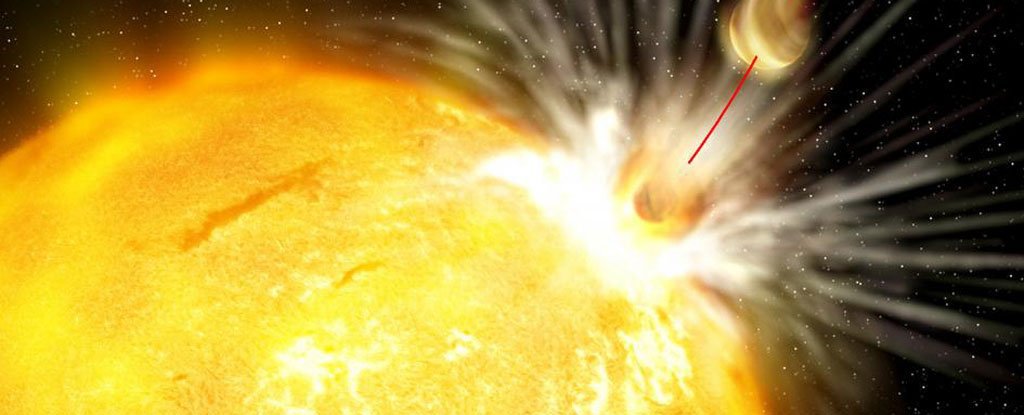Astronomers have discovered a star that swallowed up part of their planets.

The solar system is relatively stable. All the planets are in place, the Sun shines moderately brightly, ensuring the existence of life on Earth (and possibly other planets or planetoids). We, the inhabitants of the system, can be said lucky with our luminary. But this situation is not everywhere.
Recently, astronomers have discovered a star very similar to the sun. Catalog designation of "double" of our luminary - HIP68468. This star is 5.9 billion years old, and it is located 300 light years from the solar system. Scientists nicknamed her "death star", all because she swallowed one or two of their planets. Since the star is almost an exact copy of the Sun, the question arises - is it possible that the Solar System is facing something similar?
The star was discovered using a 3.6-meter telescope in Chile, the La Silla Observatory. After analyzing its spectrum, it turned out that the star contains four times more lithium than it should. Stars of this type and age are characterized by a much lower content of this metal. Most star spectra show a minimum lithium content. But planets formed from rocks, like the Earth, are usually distinguished by the fact that they contain quite a lot of this element.
')
In addition to lithium, astronomers in HIP68468 discovered a large number of other elements that are not typical of sun-like stars. Astronomers began to wonder why HIP68468 contains so much lithium and tried to find an explanation. Debra Fisher, an astronomer at Yale University, responded. “It's as if we saw a cat sitting in a birdcage. If there are yellow feathers in the cat's mouth, then there is a high probability that the cat ate the canary. ” With this phrase, Fisher wanted to say that the presence of a high concentration of lithium in a star is just as clear a sign of a planet as it absorbs a rocky planet, as much as the feathers in a cat's mouth can be a clear sign of a bird eaten.
The calculations made it possible to find out that an excess of these elements could have formed in a star after it had absorbed a planet or planets with a total mass of about six times the mass of the Earth.
By the way, the star HIP68468 was discovered not by chance, but as a result of conducting work within the framework of a project to search for the twins of the sun. Scientists for several years managed to find more than 60 such twins. Why do experts hunt for the doubles of our star?
The fact is that scientists learned information about the formation of the Solar System on the basis of observations of objects in this system. The goal of the project is to confirm or disprove the correctness of scientists as a result of the search for twins of the Sun and the analysis of the planets existing in such systems. The result of the project should be the construction of a realistic model of the formation of the solar system itself. But if we see that the other Sun is eating its planets - do we need to fear the same thing?

Scientists say no. “This does not mean that the Sun will soon eat the earth,” says Jacob Bean, co-author of the study. He works as an assistant professor of astronomy and astrophysics at the University of Chicago. “Our discovery shows us that cruel stories may be normal for planetary systems, including our own,” said Bean.
So far, scientists can not say exactly what caused the absorption of the planets by their luminaries. It may well be that a certain force has appeared in the HIP68468 star system, which has pushed the planet (or planets) towards its doom. Perhaps the reason is the orbit of the “eaten planet”, disturbed as a result of the impact of any factor.
Scientists suggest that the sun will swallow up Mercury and Venus in the course of its evolution, turning into a red giant. But this will happen no earlier than in 5 billion years. The earth, in all likelihood, will be out of the “eating” zone, but the likelihood that an increasing red giant will eat our planet does exist. Even so, it will happen no earlier than 7.6 billion years.
Of course, a man has nothing to worry about, all this will happen very soon. All life on Earth, however, will die much earlier. After 1.5 billion years, radiation will kill life on our planet, making it completely uninhabitable. So, when and if our planet enters the hearth of a red giant, into which, in the distant future, our Sun will turn, then at that time it will be completely sterile.
As for HIP68468, at least two planets rotate around this star, the size of which is several times the size of the Earth. One of them is very close to the luminary. Thus, the radius of the orbit of exoplanets HIP68468 b is about 0.02 of the distance between the Sun and the Earth. Astronomers found out that these planets could not have formed in current orbits. Most likely, they came from areas of the system more distant from the star. Perhaps, this process was accompanied by the most complicated gravitational interaction of the planets with destabilization of their usual motion. As a result, some of the planets could either go beyond the limits of the star system, or fall on their star.
Source: https://habr.com/ru/post/369993/
All Articles